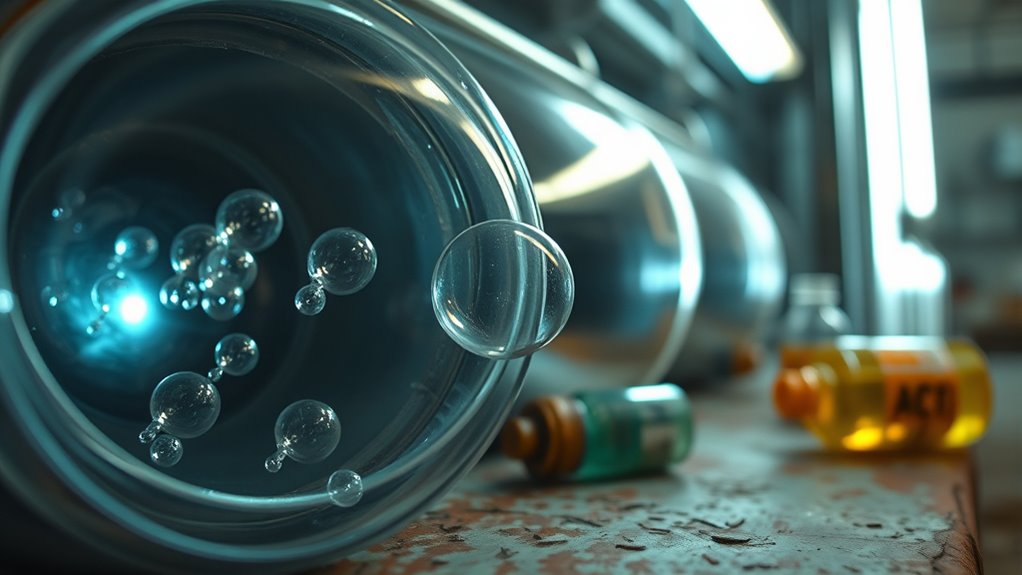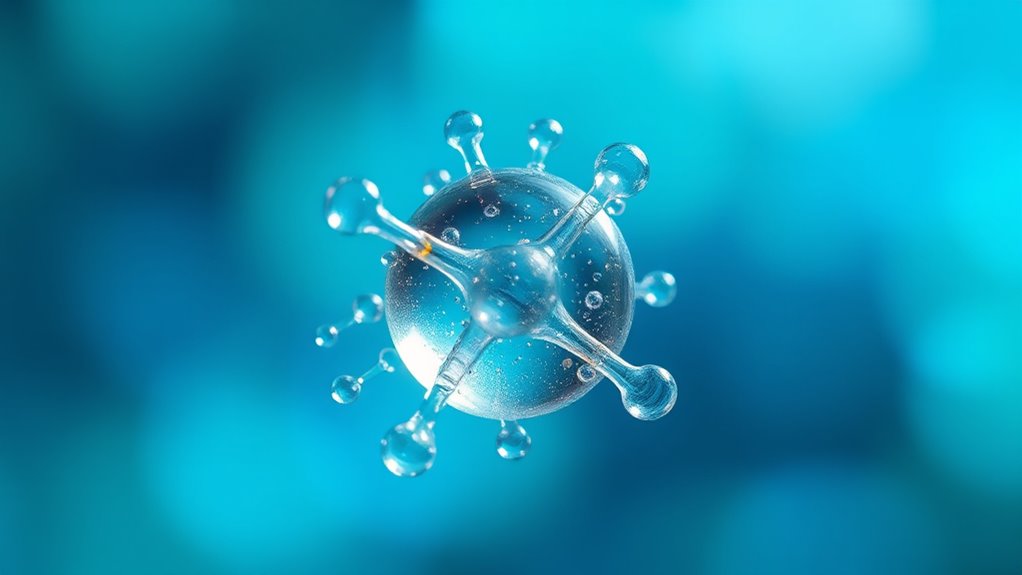Freon revolutionized our daily lives by making refrigeration and air conditioning affordable and widespread, but it also had hidden dangers. When released into the atmosphere, Freon molecules break down ozone in the stratosphere, allowing harmful UV rays to reach Earth. This led to ozone layer thinning and increased health risks like skin cancer. Although international efforts have reduced its use, Freon’s story shows how one molecule can have lasting environmental effects—if you continue exploring, you’ll discover the full impact.
Key Takeaways
- Freon revolutionized cooling technology but was later found to deplete the ozone layer.
- Its chemical stability causes it to persist in the atmosphere and catalyze ozone destruction.
- UV radiation breaks Freon molecules, releasing chlorine and bromine atoms that damage ozone.
- International efforts like the Montreal Protocol aimed to phase out Freon and protect the ozone.
- The Freon story underscores the need for environmentally responsible innovation and sustainable solutions.

Freon revolutionized refrigeration and air conditioning in the mid-20th century, making it easier and cheaper to keep food fresh and buildings cool. Its widespread use transformed industries and everyday life, but it also came with significant consequences. You mightn’t realize it, but as Freon became more popular, scientists began to notice its impact on the environment, especially concerning ozone depletion.
Freon transformed cooling but had hidden environmental costs, notably ozone depletion and climate impact.
This discovery revealed that chemicals used in cooling systems could escape into the atmosphere, where they break down ozone molecules that shield the Earth from harmful ultraviolet rays. The environmental impact of these substances was profound, threatening both ecosystems and human health. Ozone depletion accelerates skin cancers, cataracts, and disrupts marine and terrestrial life, making it a serious global concern.
As you learn more about Freon’s history, it’s clear that its initial benefits masked dangerous side effects. In the atmosphere, Freon molecules don’t simply vanish; instead, they persist for years, slowly migrating upward. Once they reach the stratosphere, they encounter UV radiation, which breaks them apart, releasing chlorine and bromine atoms.
These atoms then catalyze the destruction of ozone molecules, creating thinning ozone layers. This process, known as ozone depletion, became a critical environmental issue by the late 20th century. It prompted international action, such as the Montreal Protocol, to phase out the production of ozone-depleting substances, including many types of Freon.
Despite these efforts, the environmental impact of Freon remains a cautionary tale about technological progress and its unintended consequences. You might wonder how a molecule so small could have such a huge impact. It’s because Freon’s chemical stability allows it to remain intact in the lower atmosphere for decades, giving it ample time to reach the ozone layer. Additionally, chemical stability contributes to its persistence and environmental harm, emphasizing the importance of understanding chemical properties in environmental science.
Once there, it acts like a catalyst, repeatedly destroying ozone molecules without being consumed in the process. This ongoing destruction weakens the ozone layer, increasing the Earth’s vulnerability to harmful UV radiation. Predictive modeling helps scientists understand and forecast these environmental processes, emphasizing the importance of proactive measures. The environmental impact is far-reaching, affecting not just the ozone layer but also climate change, as some Freon compounds are potent greenhouse gases.
Their capacity to trap heat adds another layer of complexity to their environmental footprint. Today, the story of Freon serves as a reminder of how technological innovations can carry hidden costs for the planet. You now understand that while Freon helped revolutionize cooling, it also contributed to environmental degradation through ozone depletion.
The efforts to replace it with safer alternatives reflect a growing awareness of our responsibility to protect the ozone layer and reduce greenhouse gases. Moving forward, it’s essential to continue developing environmentally friendly solutions, respecting the lessons learned from Freon’s rise and fall, to ensure a healthier planet for future generations.
Frequently Asked Questions
Are There Eco-Friendly Alternatives to Freon Available Today?
You’re probably wondering if eco-friendly options exist for refrigerants today. Yes, there are refrigerant alternatives that are safer for the environment, like hydrofluoroolefins (HFOs), hydrocarbons, and some natural refrigerants such as CO2 and ammonia.
These eco-friendly options help reduce ozone depletion and global warming potential. Switching to these new refrigerant alternatives can make your appliances and systems more sustainable while maintaining efficiency and performance.
How Did Freon’s Discovery Impact Global Industries Beyond Refrigeration?
Think of Freon as a double-edged sword slicing through industries. Its discovery revolutionized industrial chemistry, expanding applications in manufacturing, aerosol propellants, and fire suppression systems.
However, it also prompted environmental policies to curb its use due to ozone depletion concerns. You see, as industries embraced Freon’s benefits, they unknowingly set the stage for global environmental shifts, forcing a shift toward sustainable alternatives and reshaping industrial practices worldwide.
What Legal Measures Were Taken to Regulate Freon Production?
You should know that regulatory bans and international treaties, like the Montreal Protocol, were vital in controlling freon production. These measures banned or restricted the use of ozone-depleting refrigerants, forcing industries to adopt safer alternatives.
Governments worldwide collaborated to enforce these regulations, reducing harmful emissions. This global effort aimed to protect the ozone layer and prevent further environmental damage caused by freon, showing the power of international cooperation in environmental regulation.
Can Freon Leaks Still Harm the Ozone Layer Today?
Your concern about freon leaks harming the ozone layer is valid, as they still pose a significant threat. Even small leaks can contribute to ozone depletion, impacting environmental health worldwide.
Although regulations have reduced production, outdated appliances and accidental leaks keep the risk alive. The ongoing environmental impact reminds us that, without vigilance, this once-revolutionary molecule can still damage our fragile ozone shield, threatening life on Earth.
How Long Does It Take for the Ozone to Recover After Freon Usage Stops?
You wonder how long ozone recovery takes after stopping Freon use. It typically takes decades for the ozone layer to fully heal, depending on environmental timelines and the amount of remaining CFCs.
Your actions matter, as reducing emissions accelerates recovery. Overall, the ozone layer’s healing process highlights the importance of sustained efforts and international cooperation to restore environmental balance over time.
Conclusion
You watch as Freon rises, a symbol of progress and promise. You see it fall, a shadow over the ozone, a reminder of consequences. You learn that innovation can uplift and undo, that science can heal and harm. You realize that the story of Freon isn’t just about molecules, but about responsibility. You understand that in every choice, there’s a ripple—upward, downward, forever etched in the atmosphere’s memory.









